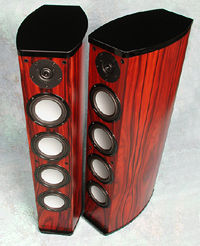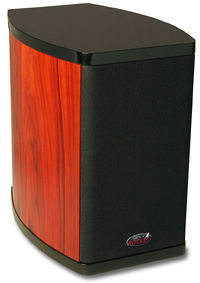Rocket Loudspeakers by Onix RS750, RSC200, RS250, and RSS300 Loudspeakers
 In the past few years, this pond has been disturbed by a tidal wave not unlike that caused by an elephant's winning entry in a belly-flop contest. Increasingly, the vast pool of labor in the People's Republic of China has been tapped to assemble and build speakers. In just a few years, most of the major speaker companies have moved much of their production to China, leaving those that claim otherwise a distinct minority.
In the past few years, this pond has been disturbed by a tidal wave not unlike that caused by an elephant's winning entry in a belly-flop contest. Increasingly, the vast pool of labor in the People's Republic of China has been tapped to assemble and build speakers. In just a few years, most of the major speaker companies have moved much of their production to China, leaving those that claim otherwise a distinct minority.
The last two speaker systems that I reviewed for Stereophile Guide to Home Theater—the Audio Pro Black Diamonds (September 2001) and the Wharfedale Pacifics (February 2002)—were both made in China. The quality of their cabinetry and overall build quality were exemplary, but there were so many similarities in cabinet structure and packaging that I suspected both systems were built in the same factory. At the prices these firms charged for their products, it didn't matter—they were very good values.
Not long after those reviews, a buzz began in the Internet chat rooms about a new speaker company taking advantage of this new situation—and sharing the savings with the average consumer by selling their speakers directly through their website. This leapfroggedtwo middlemen: the local factory representative and the displaying dealer. I've spent much of my life on retail sales floors, and at first I was skeptical—how would they give the convincing demonstrations that so many folks need before they decide which speakers to buy?
Well, the visionaries in the AV123 group, which imports and distributes Rocket Loudspeakers by Onix and is led by industry veteran Mark Schifter, already had that figured out. Products can be returned within 30 days, no questions asked, as long as they're in original condition. This allows any potential customer to audition them at home for far longer than most retailers can handle. Because the room and associated equipment can greatly affect the speakers' overall presentation, this policy is most welcome.
But Schifter's group does more than just market products. In an arrangement that goes deeper than the standard relationship between an original equipment manufacturer (OEM) and a marketing firm, AV123 owns more than half of the plant in China. The factory may make products for other companies, but when it comes to the Rocket speakers, Schifter says he controls the quality and craftsmanship throughout the manufacturing process.
Apparently, this business model has been successful. In the few years since the Rocket speakers appeared on my radar screen, the AV123 group's product offerings have multiplied greatly. In addition to the Rocket series reviewed here, they now sell subwoofers, accessories, and two smaller complete surround systems, and they recently introduced a line of high-end reference speakers. Schifter seems to be doing his job well; of the three Chinese-made systems I've reviewed, the Rockets are far and away the finest in both build and sound quality.
Stage I: The Right Stuff The first things everyone notices about the Rockets are their compelling cabinets. Each speaker has rounded side panels, which minimize internal reflections and greatly reduce side-panel vibrations. Such shapes are now common in speakers.
The Rockets' curved sides are covered in gorgeous veneers that will complement fine furniture: the South American Rosewood I received, or Macassar Ebony, a darker finish of more muted browns instead of the Rosewood's redder hues. In all Rocket models, both ends of the speakers are finished in a hand-rubbed, gloss-black lacquer with a depth of finish that hot-rod auto enthusiasts lust after (or would that beluster after?).
 The RS750 main speaker stands just over 3 feet tall, but its 9-inch width, which slopes down to a face 61/4 inches wide, makes for little physical intrusion at the front of the room. That narrow face is just wide enough for a vertical row of four custom-made, 5.25-inch aluminum woofers topped by Vifa's familiar ring-radiator tweeter.
The RS750 main speaker stands just over 3 feet tall, but its 9-inch width, which slopes down to a face 61/4 inches wide, makes for little physical intrusion at the front of the room. That narrow face is just wide enough for a vertical row of four custom-made, 5.25-inch aluminum woofers topped by Vifa's familiar ring-radiator tweeter.
The four woofers do not always act in unison. In a design reminiscent of an old Celestion 2 1/2-way speaker from the early 1980s, only the top woofer reproduces the critical midrange frequencies—it acoustically couples to the nearby tweeter to present the information shared by both drivers accurately and convincingly to the ear. As the material goes deeper, more of the woofers start to move air, so when the speaker is required to play deep bass, all four drivers are working together.
The RSC200 center-channel speaker has the same ring-radiator tweeter with a 4-inch aluminum-cone midrange directly beneath it, this pair flanked by two of the same 6.5-inch woofers as in the RS250. The RSC200 is a back-strainer—while only 25 inches wide by about a foot deep and high, it weighs a shocking 46 pounds, indicating that the cabinet is made of seriously thick, dense fiberboard to help damp unwanted vibrations. This weight doesn't sound like much on paper, but moving this speaker around was a chore; you'll want to do so as little as possible. Many rear-projection TVs with plastic cases won't be able to support an RSC200; if yours won't, consider buying a sturdy speaker stand to mount the unit in front of the screen; unfortunately, Onix doesn't make one.
Both this and Rocket's smaller RSC100 center speaker use a vertically aligned midrange and tweeter instead of the more common lateral array of woofer-tweeter-woofer. The latter, incorrect application of Joe D'Appolito's classic design causes uneven response across the room in the range where the human ear is most sensitive. Kudos to Rocket for not joining the me-too crowd of center-speaker non-engineering.
The RS250 surround speaker has a single 6.5-inch woofer and the same Vifa tweeter as in the other models. It is nearly the same width and depth as the RS750, and when a room is filled with these wood sculptures, it's a beautiful sight. I used two sets of old NHT stands to get the RS250s off the floor, but by the time this review was finished Rocket had developed a stand ($149/pair) that complements the speaker's appearance and raises the speaker 30 inches off the floor. If the RS750s aren't tall enough, 6.5-inch risers are available for $99/pair.
For standard surround applications, Onix created the RSS300. This unit's 16 1/2-inch width and 15 1/2-inch height initially sounds somewhat large, but the shallow 6 1/2-inch depth makes up for it. Near the top of the rear panel, there is a single screw slot for wall mounting.
The RSS300's face is divided into three parts, with the outer two sections at a slight angle towards the wall; each of these angled sections includes a single 5 1/4-inch woofer and 1-inch aluminum dome tweeter. Unlike full dipole speakers, the woofers play in phase with each other to maintain bass response. Only the tweeters are run out of phase in order to make it difficult for the sound to be easily localized by listeners.
Stage II: Launch Pad Originally, I'd wanted to review seven of Rocket's little RS250 minimonitors in an array of identical speakers, as recommended by Russ Herschelmann, UAV's "Home Theater Architect." However, a lengthy e-conversation with Mark Schifter convinced me to check out the RS750 towers with their curious, staggered-response woofers. At that point, I decided to get the RSC200 center-channel and a pair of the RSS300 dipolar surrounds as well, so I could investigate Rocket's more standard home-theater lineup. Schifter sent me only two pairs of RS250s; while I couldn't do the identical 7-channel setup, I could at least configure the pieces in enough different ways to satisfy my curiosity.
The system I ended up spending the most time with consisted of a pair of RS750 fronts, an RSC200 center, and two pairs of RS250 rears, available for a special package price of $2850 ($2249 with a single pair of RS250s), without subwoofers. This is barely a drop in the high-end bucket, but well above entry level. When I received this system, Rocket had not yet marketed a subwoofer; I ended up not using one for the entire review period (more on that later).





























































